#Georgiy Mikhailovich
Text
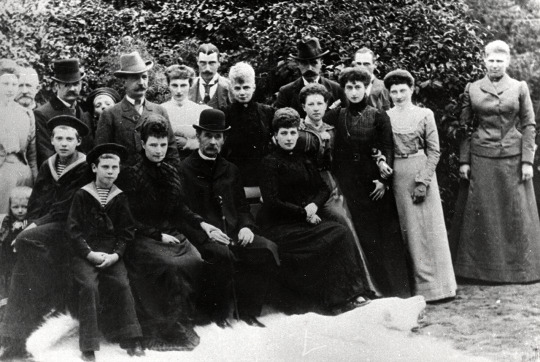
Gathering of Danish Royal Family.
Maria Feodorovna, nee Dagmar of Denmark, is seen in the front row next to her father and nephews. Maria Georgievna, nee of Greece and Denmark, is between her aunt Alexandra and cousin Maud. Behind her is her (future? not sure of the date on this one) husband, Georgiy Mikhailovich.
#romanov#danish royal family#maria feodorovna#maria georgievna#georgiy mikhailovich#alexandra of denmark#christian ix of denmark#frederick viii of denmark#alexandrine of mecklenburg schwerin#thyra of denmark#maud of norway#christian x of denmark#my collection
20 notes
·
View notes
Note
Hello! Was the marriage of George Mikhailovich and his wife really disastrous? Thank you.
Hello there! Thank you for your question.
Grand Duke Georgiy Mikhailovich married Princess Maria of Greece and Denkark in 1900. Upon the marriage, she became 'Maria Georgievna'. Georgiy seemed very much in love with Maria at first, he courted her for five years before she decided to marry him, having turned him down initially. They seemed to be, on paper, a good match - they were notably both very artistic, and together they designed their own English-style house in the Crimea, called Harax.

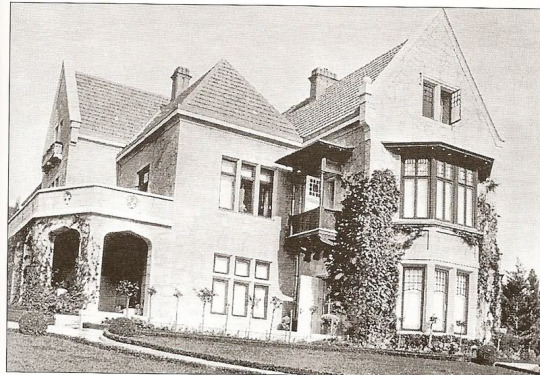
They were close with the Romanovs, especially Xenia Alexandrovna, who was Maria's best friend, cousin, AND sister-in-law! Georgiy and Maria's daughters occasionally played with Maria and Anastasia Nikolaevna, and were friendly with Nicholas and Alexandra.


Unfortunately, Maria never seemed to be able to settle in Russia and longed to return to Greece, which I suspect put strain on the marriage. The final blow (in my opinion) came in 1913, when Maria's father King George I of Greece was assassinated. It was such a shock and she was devastated. This was even more distressing as it was the Romanov Tercentenary year, and Georgiy and Maria were expected to attend celebrations, despite being deep in mourning.
Maria seemed to have been deeply unhappy, and took her children to London in 1914 as a way to take a break from the marriage, with Georgiy meant to follow them to London later on. Of course, Maria couldn't have predicted war would break out, but it meant that there was an excuse to stay in London and away from Russia where she was unhappy, as her and her daughters couldn't travel back to Russia due to the danger it posed. It is believed that her daughters, Nina and Xenia, who had tumultuous relationship with their mother, always resented her for taking them away from their father in 1914 - he would be shot in 1919, and they would never see him again after the move to London.
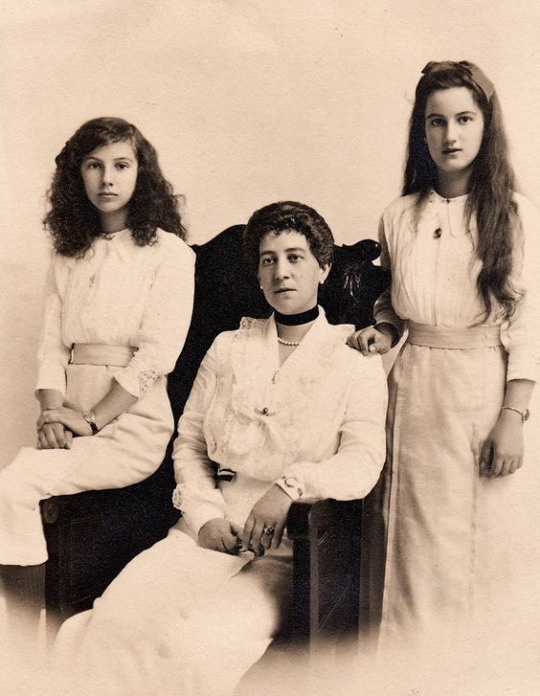
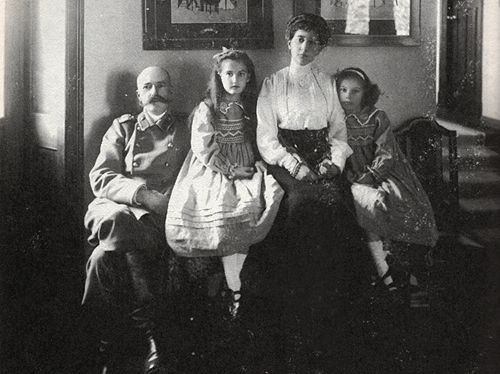
Despite this, there was clearly some affection between Georgiy and Maria. From London, Maria tried desperately to help Georgiy, contacting Russian relatives, the Danish embassy, and offering £50,000 (almost £3,000,000 today) of her own money in return for him being freed.
So, their marriage wasn't absolutely disastrous - there seems to have been some closeness and they clearly shared common interests. Their collaboration on Harax especially indicates that they had a good partnership. Despite this, Maria never seemed able to fall in love with Georgiy, or Russia. It wasn't a success by any means, but they did not hate each other.
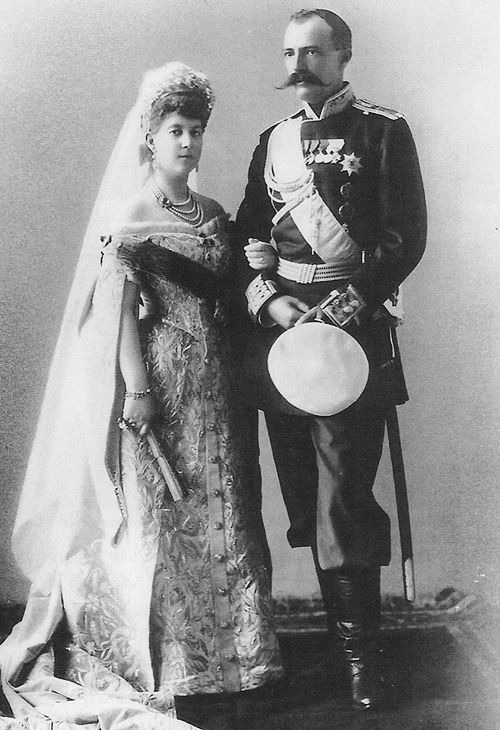
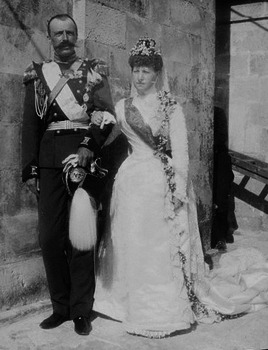
#q#anon#ask#answered#Maria Georgievna#Maria of Greece and Denmark#George Mikhailovich#Georgiy Mikhailovich#Nicholas II#Xenia Alexandrovna#Harax#Harax palace#1919#Xenia Georgievna#Nina Georgievna#Mikhailovichi
13 notes
·
View notes
Photo

“The August Family” poster or possibly a calendar cover (?)
#Romanov#Russia#Nicholas II.#Alexandra Fyodorovna#Maria Fyodorovna#Xenia Alexandrovna#Alexander Mikhailovich#Georgiy Alexandrovich#mikhail Alexandrovich#olga Alexandrovna
111 notes
·
View notes
Text

Grand Duke Georgiy Mikhailovich of Russia with his daughter, Princess Nina Georgievna.
44 notes
·
View notes
Text
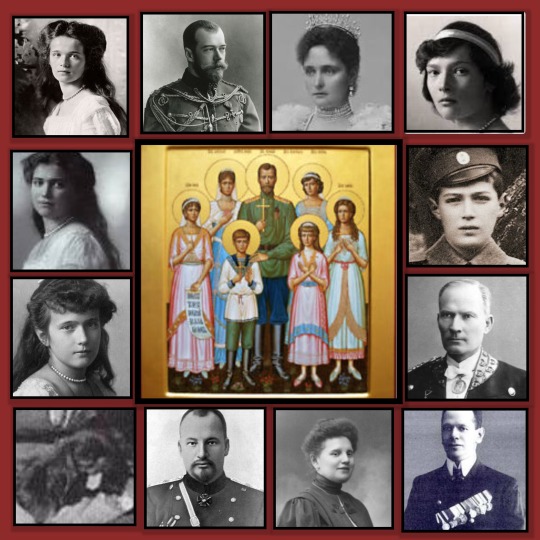
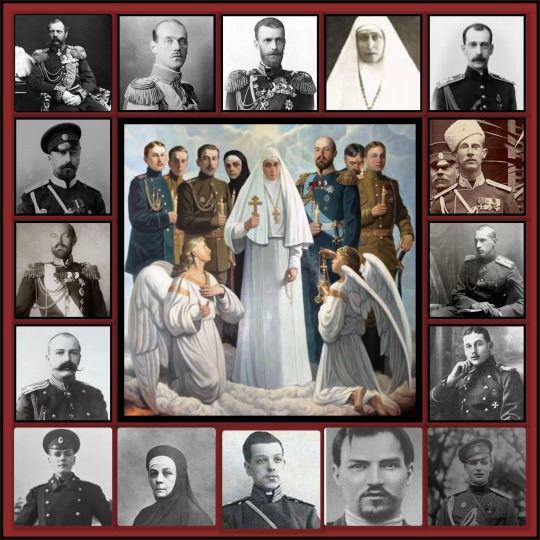
The Romanov Martyrs
I wanted to put together a little memorial that included all the members of the Romanov Family (as well as the members of their staff) that were murdered by the Bolshevik terrorists. This seems like a good week to keep them in our minds. Although we love and mourn the children especially, there were others we cannot forget.
Tsar Alexandre II was hunted down until finally blown to pieces.
Dowager Empress Maria Feodorovna lost two sons and five grandchildren (no wonder she could not accept they were dead)
Grand Duke Sergei Alexandrovich was also hunted down and blown to pieces
Three Mikhailovichi brothers were murdered
Four Konstantinovichi were murdered, three of them brothers; I cannot imagine what their mother, Grand Duchess Elizabeth Mavrikievna, went through...and so on.
May they rest in peace.
#russian history#imperial russia#romanov family#Nicholas II#Tsar Alexander II#Empress Alexandra Feodorovna#Grand Duchess Elizabeth Feodorovna#OTMAA#Grand Duke Mikhail Alexandrovich#Grand Duke Sergei Alexandrovich#Grand Duke Pavel Alexandrovich#Grand Duke Nicholas Mikhailovich#Grand Duke Georgiy Mikhailovich#Grand Duke Sergei Mikhailovich#Grand Duke Dmitry Konstantinovich#Prince Ioann Konstantinovich#Prince Igor Konstantinovich#Prince Konstantin Konstantinovich#Dr. Eugene Botkin#Anna Demidova#ivan karitonov#Akexei Trupp#Sister Varvara Yakolevna#Feodor Remez#mr. johnson
71 notes
·
View notes
Text

Currently there is no known photos of the wedding of Tsar Nicholas II of Russia and Princess Alix of Hesse and By Rhine on 14 November 1894 ( 26 November 1894 N.S.) at the Grand Church of the Winter Palace.Of course they may still be in the Russian Archives,not yet released
On 19 April 1894, Tsarevich Nikolai Alexandrovich Romanov of Russia was at the wedding of Ernst-Ludwig Grand Duke of Hesse, to their mutual cousin,Princess Victoria Melita of Saxe-Coburg and Gotha. Nicholas had also obtained permission from his parents, Tsar Alexander III and Empress Marie Feodorovna, to propose to Ernst's younger sister, Princess Alix of Hesse and by Rhine.The Emperor and Empress had initially been opposed to the match. However, Nicholas, who had first met Alix a decade earlier in St. Petersburg when Alix's sister, Princess Elisabeth of Hesse and by Rhine, married Nicholas's uncle, Grand Duke Sergei Alexandrovich Romanov of was not to be dissuaded. Furthermore, Tsar Alexander's health was beginning to fail.
Shortly after arriving in Coburg, Nicholas proposed to Alix. However, Alix, who was a devout Lutheran, rejected Nicholas's proposal, as in order to marry the heir to the throne, she would have to convert to Russian Orthodoxy.However, Alix's cousin, Kaiser Wilhelm II of Germany, who had been at the wedding, insisted that it was her duty to marry Nicholas, despite her religious scruples.Elisabeth also spoke with her, insisting that there were not that many differences between Lutheranism and Orthodoxy. At the prompting of the Kaiser, Nicholas proposed for the second time, and she accepted.
On 1 November 1894, Alexander III died at Maly Palace, Livadia, leaving twenty-six-year-old Nicholas as the next Tsar of Russia. The following day, Alix, who had arrived at Livadia several days earlier in order to receive the dying Tsar's blessing, was received into the Russian Orthodox Church as Grand Duchess Alexandra Feodorovna.Alix had apparently expressed her wish to take the name Catherine, but decided to take the name Alexandra on Nicholas's request.
Guests
The groom's family
•The Dowager Empress Marie Feodorovna of Russia ~ mother of Nicholas II
•Grand Duchess Xenia Alexandrovna Romanova of Russia ~ sister of Nicholas ll
•Grand Duke Alexander Mikhailovich Romanov of Russia ~ brother-in-law and first cousin once removed) of Nicholas II
•Grand Duke Mikhail Alexandrovich Romanov of Russia, brother of Nicholas II
•Grand Duchess Olga Alexandrovna Romanova of Russia, sister of Nicholas II
•Grand Duke Vladimir Alexandrovich Romanov of Russia ~ paternal uncle of Nicholas II
Grand Duchess Marie Pavlovna Romanova of Russia (the Elder) ~ paternal aunt by marriage of Nicholas II
•Grand Duke Kyril Vladimirovich Romanov of Russia ~ paternal first cousin of Nicholas II
•Grand Duke Boris Vladimirovich Romanov of Russia ~ paternal first cousin of Nicholas II
•Grand Duke Andrei Vladimirovich Romanov of Russia ~ paternal first cousin of Nicholas II
•Grand Duchess Elena Vladimirovna Romanova of Russia ~ paternal first cousin of Nicholas II
•Grand Duke Alexei Alexandrovich Romanov of Russia ~ paternal uncle of Nicholas II
•Grand Duke Sergei Alexandrovich Romanov of Russia ~ paternal uncle of N0icholas II
Grand Duchess Elisabeth Feodorovna Romanova of Russia ~ sisters-in-law and paternal aunt by marriage of Nicholas II
•Grand Duke Pavel Alexandrovich Romanov of Russia ~ paternal uncle of Nicholas II
•Grand Duchess Alexandra Iosifovna Romanova of Russia ~ paternal grandaunt by marriage of Nicholas II
•Grand Duke Konstantin Konstantinovich Romanov of Russia ~ first cousin,once removed of Nicholas II
•Grand Duchess Elizaveta Mavrikievna Romanova of Russia ~ first cousin once removed by marriage of Nicholas II
•Grand Duke Dmitri Konstantinovich Romanov of Russia ~ first cousin once removed of Nicholas II
•Duchess Vera of Württemberg, first cousin once removed of Nicholas II (representing the King of Württemberg)
•Grand Duke Mikhail Nikolaevich Romanov of Russia ~ paternal granduncle of Nicholas II
•Grand Duke Nikolai Mikhailovich Romanov of Russia ~ first cousin once removed of Nicholas II
•Grand Duke Georgiy Mikhailovich Romanov of Russia ~ first cousin once removed of Nicholas II
•Grand Duke Sergei Mikhailovich Romanov of Russia ~ first cousin once removed of Nicholas II
•King Christian lX of Denmark ~ maternal grandfather of Nicholas II
•King George l of the Hellenes ~ maternal uncle of Nicholas ll
•Queen Olga of the Hellenes ~ maternal aunt and first cousin once removed of Nicholas II
•Prince George of Greece and Denmark ~ first cousin of Nicholas II
•Prince Valdemar of Denmark ~ maternal uncle of Nicholas II
The bride's family
•Grand Duke Ernst-Ludwig of Hesse and by Rhine ~ brother of Alexandra Feodorovna
•Princess Irene of Prussia ~ Sister of Alexandra Feodorovna
•Prince Henry of Prussia ~ brother-in-law and maternal first cousin of Alexandra Feodorovna (representing the German Emperor)
•Edward, Prince of Wales ~ uncle of both Alexandra and Nicholas (representing the Queen of the United Kingdom)
•Alexandra,Princess of Wales ~ aunt of both Alexandra and Nicholas (representing the Queen of the United Kingdom)
•The Prince George,Duke of York ~ Alexandra and Nicholas' mutual first cousin
•Alfred,Duke and Duchess of Saxe-Coburg-Gotha ~ uncle of Alexandra Feodorovna and uncle by marriage of Nicholas ll
•Grand Duchess Maria Alexandrovna Romanova,Duchess of Saxe-Coburg-Gotha ~ aunt of Nicholas ll and aunt by marriage of Alexandra Feodorovna
•Ferdinand, Crown Prince of Romania, husband of Alexandra and Nicholas' mutual first cousin (representing the King of Romania)
Foreign Royalty
•Mecklenburg : Duke John Albert of Mecklenburg ~ second cousin once removed of Nicholas II (representing the Grand Duke of Mecklenburg-Schwerin)
•Grand Duchy of Baden : Prince Wilhelm and Princess Maria Maximilianovna of Baden, second cousin once removed of both Nicholas and Alexandra, and first cousin once removed of Nicholas II (representing the Grand Duke of Baden)
•The Duke of Leuchtenberg, first cousin once removed of Nicholas II
Prince George Maximilianovich and Princess Anastasia of Leuchtenberg, first cousin once removed of Nicholas II and his wife
•Grand Duchy of Oldenburg : Duke Alexander Petrovich and Duchess Eugenia Maximilianovna of Oldenburg, second cousin once removed and first cousin once removed of Nicholas II (cousin of the Grand Duke of Oldenburg)
•Grand Duchy of Oldenburg : Duke Peter Alexandrovich of Oldenburg ~ second cousin of Nicholas II
•Grand Duchy of Oldenburg : Duke Constantine Petrovich of Oldenburg ~ second cousin once removed of Nicholas II
•Grand Duchy of Mecklenburg-Strelitz : Duke Georg Alexander of Mecklenburg-Strelitz ~ second cousin once removed of Nicholas II (nephew of the Grand Duke of Mecklenburg-Strelitz)
•Grand Duchy of Mecklenburg-Strelitz : Duke Karl Michael of Mecklenburg-Strelitz ~ second cousin once removed of Nicholas II
•Duchy of Saxe-Altenburg Prince Albert and Princess Helene of Saxe-Altenburg ~ third cousin once removed of both Nicholas and Alexandra, and second cousin once removed of Nicholas II (representing the Duke of Saxe-Altenburg)
63 notes
·
View notes
Photo
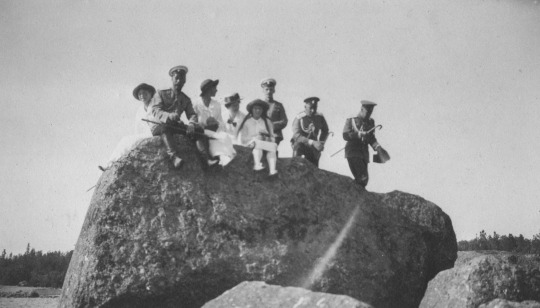
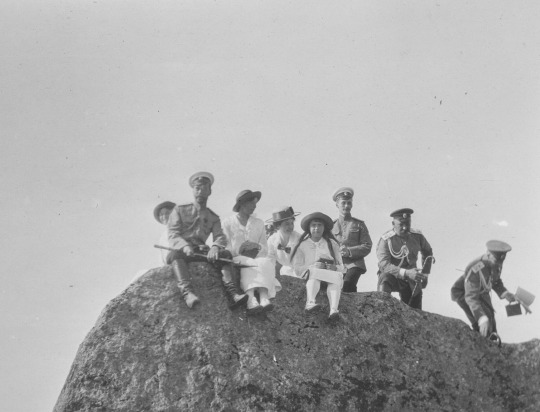
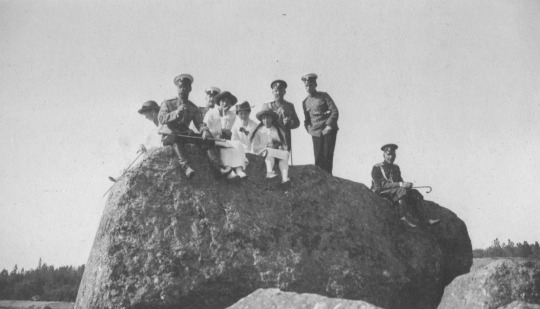

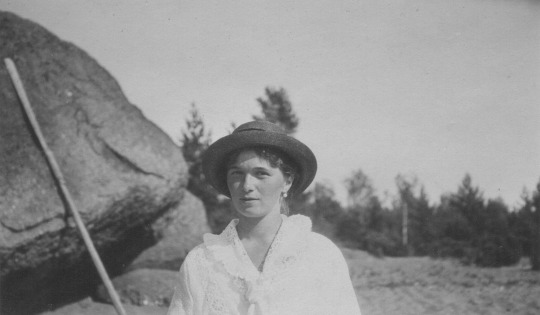
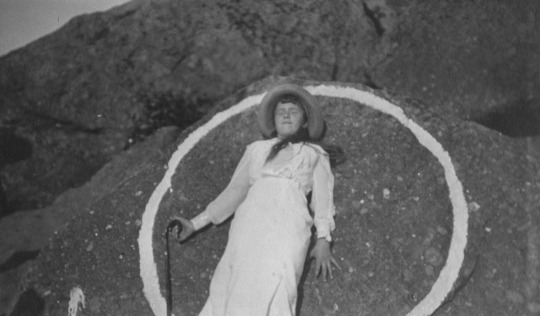
3rd July 1914
Photo 1-3 : Grand Duchess Olga Nikolaevna, Tsar Nicholas II, Grand Duchess Tatiana Nikolaevna, Countess Anastasia Hendrikova, Grand Duchess Anastasia Nikolaevna, Hippolyte Mikhailovich Mochalov, Count Alexander Nikolaevich Grabbe and an unknown officer, on Padio-Sari, 3rd July 1914.
Photo 4 : Grand Duchess Anastasia Nikolaevna, Vladimir Konstantinovich Molokhovets, Grand Duchess Olga Nikolaevna and Georgiy Nik. Taube on Padio-Sari, 3rd July 1914.
Photo 5 : Grand Duchess Olga Nikolaevna on Padio-Sari, 3rd July 1914.
Photo 6 : Grand Duchess Anastasia Nikolaevna on Padio-Sari, 3rd July 1914.
"3rd July. Thursday.
In the morning, went boating with Papa, Olga on the steering wheel. Boat learning. Kern on barge N°1, Taube N°2, Molokhovets on [?], N.N. on [?]. Had breakfast, drank tea and had dinner with everyone. In the afternoon, went for a walk on Padio-Sari. It was very warm. N.N. was not there. After tea sat with N.N., after dinner, at first in the wheelhouse, where Olga, Molokhovets, Kern and Taube were still sitting, then on the deck with N.N. It was terribly good."
(1914 Diary of Grand Duchess Tatiana Nikolaevna)
Photos from:
Grand Duchess Olga Nikolaevna's 1914-1915 Album
Grand Duchess Maria Nikolaevna's 1914 - 1916 Album
Anna Vyrubova's Album n°3
#Olga Nikolaevna Romanova#Tatiana Nikolaevna Romanova#Anastasia Nikolaevna Romanova#Nicholas II#Count Alexander Nikolaevich Grabbe#Countess Anastasia Hendrikova#Padio sari#OTA#Georgiy Nikolaevich Taube#Vladimir Konstantinovich Molokhovets#1914
45 notes
·
View notes
Text
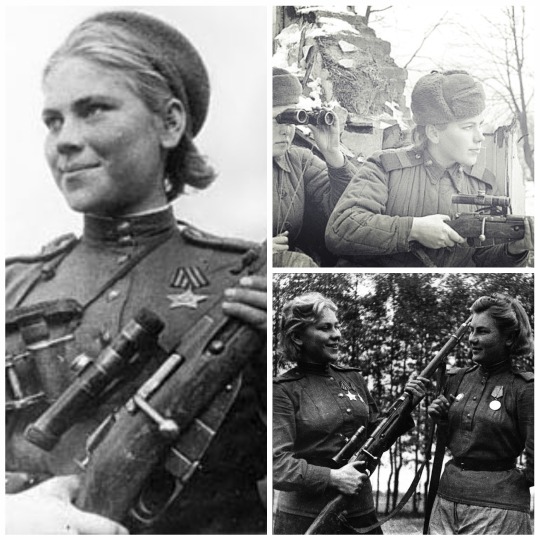
• Roza Shanina
Roza Georgiyevna Shanina, was a Soviet sniper during World War II who was credited with fifty-nine confirmed kills. Shanina volunteered for the military after the death of her brother in 1941 and chose to be a marksman on the front line. Praised for her shooting accuracy, Shanina was capable of precisely hitting enemy personnel and making doublets (two target hits by two rounds fired in quick succession).
Roza Shanina was born on April 3rd, 1924 in the Russian village of Yedma in Arkhangelsk Oblast to Anna Alexeyevna Shanina, and Georgiy Mikhailovich Shanin, who had been disabled by a wound received during World War I. Roza had six siblings: one sister Yuliya and five brothers: Mikhail, Fyodor, Sergei, Pavel and Marat. Following the German invasion of the Soviet Union, Arkhangelsk was bombed by the Luftwaffe, and Shanina and other townspeople were involved in firefighting and mounted voluntary vigils on rooftops to protect a kindergarten Roza had been working at.
Shanina's two elder brothers had volunteered for the military. In December 1941, a death notification was received for her brother Mikhail, who had died during the Siege of Leningrad. In response, Shanina went to the military commissariat to ask for permission to serve. Two more of Shanina's brothers died in the war. At that time the Soviet Union had begun deploying female snipers because they had flexible limbs, and it was believed that they were patient, careful and cunning. On June 22nd, 1943, while still living in the dormitory, Shanina was accepted into the Vsevobuch program for universal military training. After Shanina's several applications, the military commissariat finally allowed her to enroll in the Central Women’s Sniper Training School.
Honed to a fine point, Shanina scored highly in training and graduated from the academy with honours. She was asked to stay as an instructor there, but refused due to a call of duty. In 1941–1945 a total of 2,484 Soviet female snipers were deployed for the war and their combined tally of kills is estimated to be at least 11,280. Shanina on April 2nd, 1944 joined the 184th Rifle Division, where a separate female sniper platoon had been formed. Shanina was appointed a commander of that platoon. Three days later, southeast of Vitebsk, Shanina killed her first German soldier. In Shanina's own words, recorded by an anonymous author, her legs gave way after that first encounter and she slid down into the trench, saying, "I've killed a man." Shanina was awarded her first military decoration, the Order of Glory 3rd Class, on April 18th, 1944. She became the first servicewoman of the 3rd Belorussian Front to receive that order.
By May 1944, her sniper tally increased to 17 confirmed enemy kills, and Shanina was praised as a precise and brave soldier. The same year, on 9 June, Shanina's portrait was featured on the front page of the Soviet newspaper Unichtozhim Vraga. When Operation Bagration commenced on June 22nd, 1944, it was decided that female snipers would be withdrawn. They voluntarily continued to support the advancing infantry anyway, and despite the Soviet policy of sparing snipers, Shanina asked to be sent to the front line. From June 26th-28th, 1944, Shanina participated in the elimination of the encircled German troops near Vitebsk. In August 1944 advancing Soviet troops had reached the Soviet border with East Prussia and by August 31st of that year Shanina's battle count reached 42 kills. Shanina's 184th Rifle Division became the first Soviet unit to enter East Prussia.
In October 1944 Shanina became eligible for the Order of Glory 1st Class for her actions in a battle, but ultimately received the Medal for Courage instead. She was among the first female snipers to receive the Medal for Courage. On December 12th, 1944, an enemy sniper shot Shanina in her right shoulder. She wrote in her diary that she had not felt the pain, "the shoulder was just scalded with something hot." In the face of the East Prussian Offensive, the Germans tried to strengthen the localities they controlled against great odds. In a diary entry from January 1945, Shanina wrote that despite her wish to be in a safer place, some unknown force was drawing her to the front line. On January 27th, 1945 Shanina was severely injured and was later found by two soldiers disemboweled, with her chest torn open by a shell fragment. Despite attempts to save her, Shanina died the following day. Her final sniper tally reached fifty-nine confirmed kills.
In 1964–65 a renewed interest in Shanina arose in the Soviet press, largely due to the publication of her diary. The local school where she studied in 1931–35 has a commemorative plate. In Arkhangelsk, regular shooting competitions were organized among members of the paramilitary DOSAAF sport organisation for the Roza Shanina Prize, while Novodvinsk organized an open shooting sports championship in her memory.
#world war 2#world war ii#second world war#history#long post#russian history#sniper#strong female#women in history#military history#soviet#biography
48 notes
·
View notes
Photo
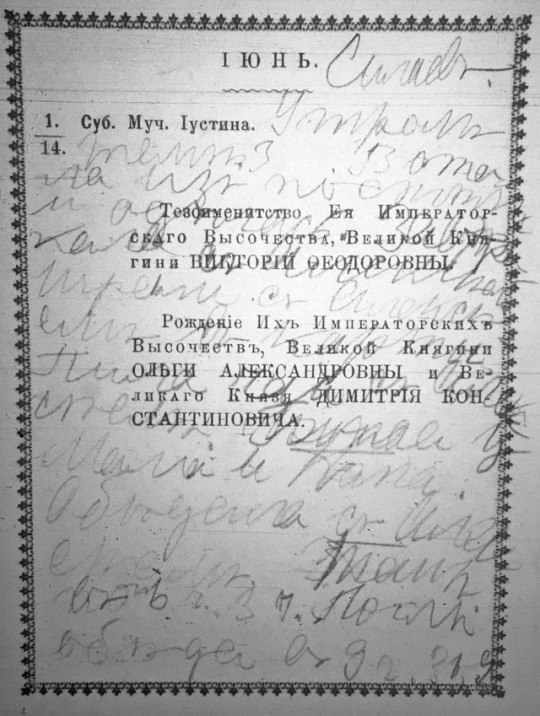
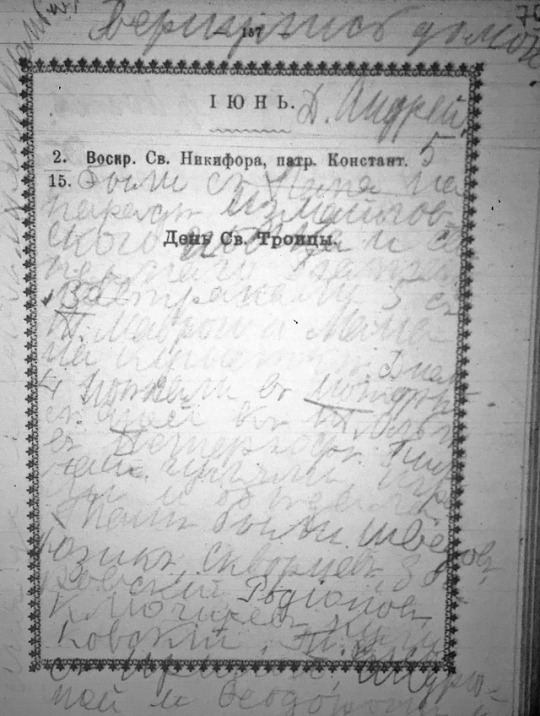
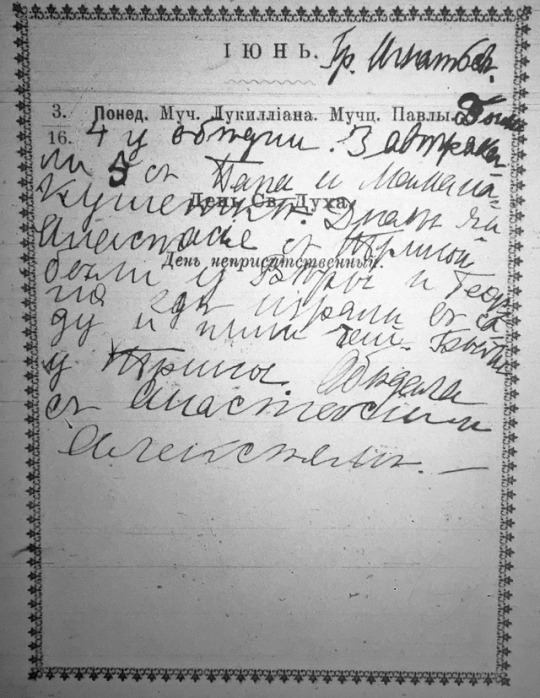
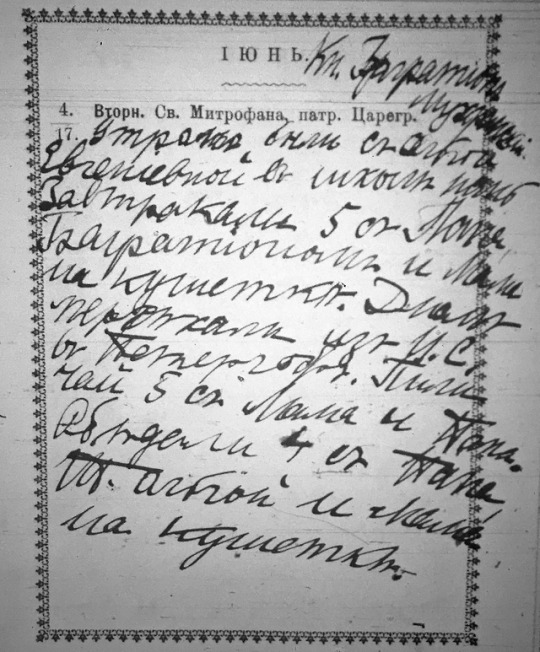


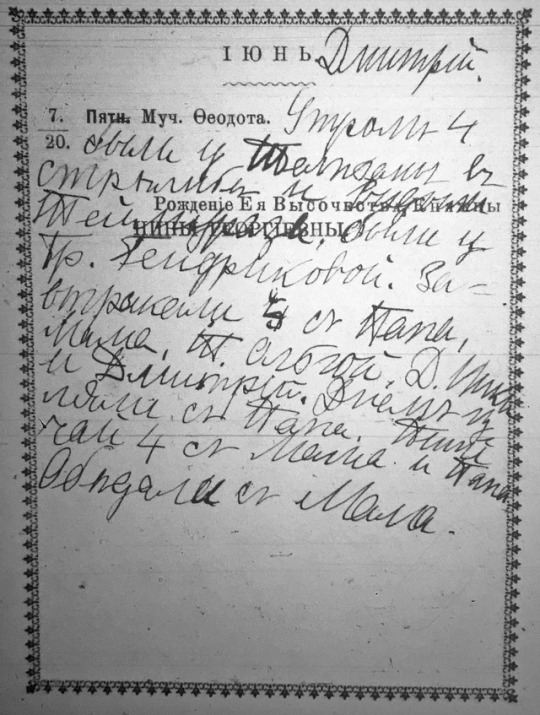
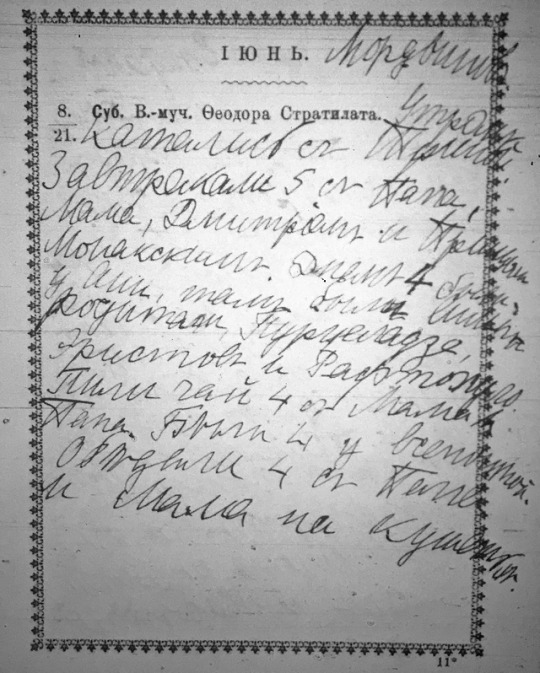
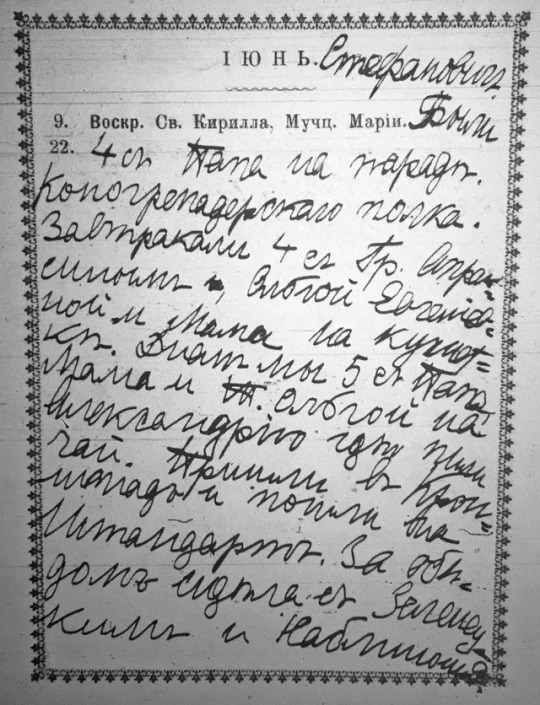
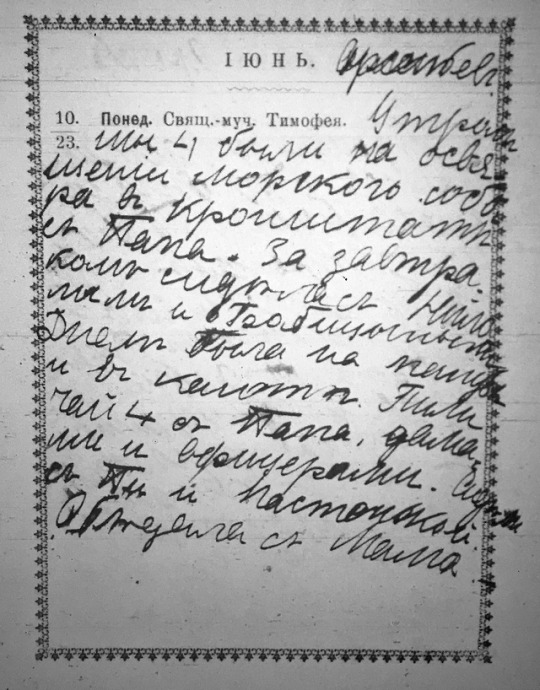
Maria Nikolaevna’s 1913 diary, 1st/14th - 10th/23rd June (translated by Helen Azar).
‘Had tea 5 with Mama and Papa’ = ‘We 5 had tea with Mama and Papa’ The 5 means Maria and all her siblings. 4 means just Maria and her sisters.
Anya = Anna Vyrubova
Andrusha: Andrei Alexandrovich
Aunt Mavra: Elizabeth Mavrikievna
Ioannchik: Ioann Konstantinovich
Trina: Catherine Schneider
Uncle Niki: Nicholas Konstantinovich
Uncle Sandro: Alexander Mikhailovich
1st/14th June:
“Dark in the morning, got up from bed and got dressed. Had breakfast with Anastasia, played cards with Alexei. Had tea in bed. [illeg] at Mama’s and Papa’s. Had dinner with Alexei. Temp[ature] at 6 o’cl. 37. After dinner at 9 o’cl. 36.9.”
2nd/15th June:
“5 went with Papa to a parade of the Izmailovsky Regiment and the Northern Battalion. Had breakfast 5 with Aunt Mavra and Mama on the sofa. In the afternoon 4 went in a motor with Anya to Aunt Olga’s in Peterhof. Had tea, took a walk. Played and had dinner. There were: Shvedov, Yuzik, Skvortzov, Zborovsky, Rodionov, Klyucharev, Kulikovsky, Aunt Ksenia with Irina [Alexandrovna], Andrusha and Feodor and Anya and Semyonov. Returned home.”
3rd/16th June:
“Went 4 to obednya. Had breakfast 5 with Papa and Mama on the sofa. In the afternoon Anastasia and I with Trina went to Vera’s and Georgiy’s [children on ‘Aunt Mavra’] where we played in the garden and had tea. Went to Trina’s. Had dinner with Anastasia and Alexei.”
4th/17th June:
“In the morning went with Agatha Evgenievna to the nanny school. Had breakfast 5 with Papa, Bagration and Mama on the sofa. In the afternoon drove from T.S. to Peterhof. Had tea 5 with Mama and Papa. Had dinner 4 with Papa, Aunt Olga and Mama on the sofa.”
5th/18th June:
“4 went to molebna with Mama. Had breakfast 5 with Mama, Papa. Ioannchik with Uncle Niki. In the afternoon took a walk with Papa. Had tea with Papa, Mama, Aunt Olga and Sonia Dehn and her boy. Had dinner with Anastasia and Alexei.”
6th/19th June:
“The dentist was here in the morning. Had breakfast 5 Papa, Mama, Aunt Ksenia, Uncle Sandro and their children. Went to Aunt Olga’s [and] had tea there and played. [There] were: Shvedov, Yuzik, Skvortzov, Zborovsky, Kulikovsky and Aunt Ksenia with 4 strannitzy. Had dinner with Anastasia and Alexei.”
7th/20th June:
“In the morning 4 went to Tatiana’s in Strelna and saw Teymuraz. Went to Countess Hendrikova. Had breakfast 5 with Papa, Mama, Aunt Olga, Uncle Niki and Dmitri. In the afternoon took a walk with Papa. Had tea 4 with Mama and Papa. Had dinner with Mama.”
8th/21st June:
“In the morning rode around with Trina. Had breakfast 5 with Papa, Mama, Dmitri and [illeg] Monaksky [?]. In the afternoon 4 went to Anya’s, there were Anya’s parents, Purtzeladze, Eristov and Ravtopulo. Had tea 4 with Mama and Papa. Went 4 to vsenoshnaya. Had dinner 4 with Papa and Mama on the sofa.”
9th/22nd June:
“Went 4 with Papa to a parade of the Equestrian Grenadier Regiment. Had breakfast 4 with Count Apraksin and Olga Evgenievna and Mama on the sofa. In the afternoon we with Papa, Mama and Aunt Olga [went] to the ‘Alexandria’ were we had tea. Arrived in Kronshtadt and went to the ‘Standart.’ At dinner sat with Zelenetzky and Sablin.”
10th/23rd June:
“In the morning we 4 went to the consecration of the Navy Cathedral in Kronshtadt with Papa. At breakfast sat with Nilov and Babitzyn. In the afternoon was on the deck and in the cabin. Had tea 4 with Papa, the ladies and officers. Sat with Pi and Nastenka. Had dinner with Mama.”
#trans: helen azar#maria nikolaevna#1913#1910s#maria diary entry#romanov#romanovs#grand duchess maria
38 notes
·
View notes
Photo

Roza Shanina was a Soviet sniper during World War II who was credited with fifty-nine confirmed kills, including twelve soldiers during the Battle of Vilnius. Shanina volunteered for the military after the death of her brother in 1941 and chose to be a marksman on the front line. Praised for her shooting accuracy, Shanina was capable of precisely hitting enemy personnel and making doublets (two target hits by two rounds fired in quick succession).
In 1944, a Canadian newspaper described Shanina as “the unseen terror of East Prussia”. She became the first Soviet female sniper to be awarded the Order of Glory and was the first servicewoman of the 3rd Belorussian Front to receive it. According to the report of Major Degtyarev (the commander of the 1138th Rifle Regiment) for the corresponding commendation list, between 6 and 11 April Shanina killed 13 enemy soldiers while subjected to artillery and machine gun fire. By May 1944, her sniper tally increased to 17 confirmed enemy kills, and Shanina was praised as a precise and brave soldier. The same year, on 9 June, Shanina’s portrait was featured on the front page of the Soviet newspaper Unichtozhim Vraga.
When Operation Bagration commenced in the Vitebsk region on 22 June 1944, it was decided that female snipers would be withdrawn. They voluntarily continued to support the advancing infantry anyway, and despite the Soviet policy of sparing snipers, Shanina asked to be sent to the front line. Although her request was refused, she went anyway. Shanina was later sanctioned for going to the front line without permission, but did not face a court-martial. She wanted to be attached to a battalion or a reconnaissance company, turning to the commander of the 5th Army, Nikolai Krylov. Shanina also wrote twice to Joseph Stalin with the same request.

Roza Shanina was born on 3 April 1924 in the Russian village of Yedma (Arkhangelsk Oblast) to Anna Alexeyevna Shanina, a kolkhoz milkmaid, and Georgiy Mikhailovich Shanin, a logger who had been disabled by a wound received during World War I.
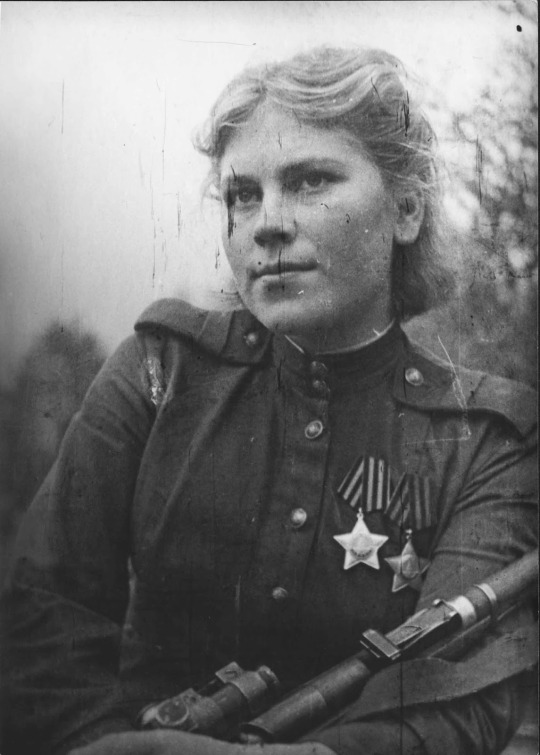
In December 1941, a death notification was received for her 19-year-old brother Mikhail, who had died during the Siege of Leningrad. In response, Shanina went to the military commissariat to ask for permission to serve.
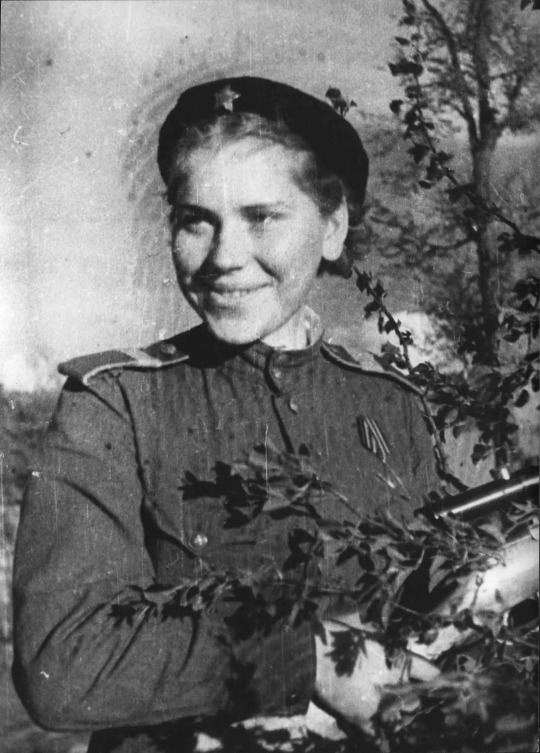
After Shanina’s several applications, the military commissariat finally allowed her to enroll in the Central Female Sniper Academy, where she met Aleksandra “Sasha” Yekimova and Kaleriya “Kalya” Petrova, who became her closest friends, with Shanina calling them “the vagrant three”.
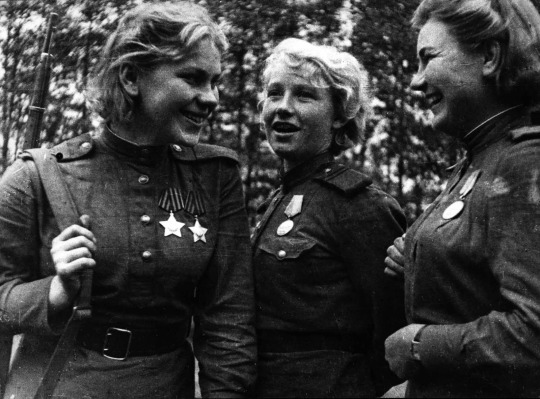
In the face of the East Prussian Offensive, the Germans tried to strengthen the localities they controlled against great odds. In a diary entry dated 16 January 1945, Shanina wrote that despite her wish to be in a safer place, some unknown force was drawing her to the front line. In the same entry she wrote that she had no fear and that she had even agreed to go “to a melee combat”. The next day, Shanina wrote in a letter that she might be on the verge of being killed because her battalion had lost 72 out of 78 people. Her last diary entry reports that German fire had become so intense that the Soviet troops, including herself, had sheltered inside self-propelled guns.
On 27 January Shanina was severely injured while shielding a wounded artillery officer. She was found by two soldiers disemboweled, with her chest torn open by a shell fragment. Despite attempts to save her, Shanina died the following day near the Richau estate (later a Soviet settlement of Telmanovka. Shanina was buried under a spreading pear tree on the shore of the Alle River (now called the Lava) and was later reinterred in the settlement of Znamensk, Kaliningrad Oblast.
In 1964–65 a renewed interest in Shanina arose in the Soviet press, largely due to the publication of her diary. The newspaper Severny Komsomolets asked Shanina’s contemporaries to write what they knew about her. Streets in Arkhangelsk, Shangaly and Stroyevskoye were named after her, and the village of Yedma has a museum dedicated to Shanina. The local school where she studied in 1931–35 has a commemorative plate.
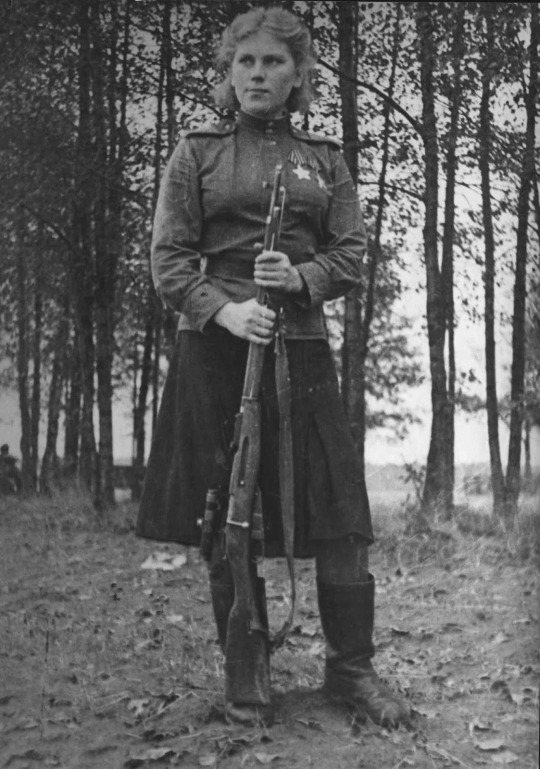
Shanina’s personal life was thwarted by war. On 10 October 1944, she wrote in her diary, “I can’t accept that Misha Panarin doesn’t live anymore. What a good guy! [He] has been killed … He loved me, I know, and I him … My heart is heavy, I’m twenty, but I have no close [male] friend”.
In November 1944, Shanina wrote that she “is flogging into her head that [she] loves” a man named Nikolai, although he “doesn’t shine in upbringing and education”. In the same entry she wrote that she did not think about marriage because “it’s not the time now”. She later wrote that she “had it out” with Nikolai and “wrote him a note in the sense of but I’m given to the one and will love no other one“. Ultimately in her last diary record, filled with sombre tones, Shanina wrote that she “cannot find a solace” now and is “of no use to anyone”.

After Shanina’s death, the diary, consisting of three thick notebooks, was kept by the war correspondent Pyotr Molchanov for twenty years in Kiev. An abridged version was published in the magazine Yunost in 1965.
110 notes
·
View notes
Text

King George I of the Hellenes with his daughters.
Both Alexandra (right) and Maria eventually married Romanovs and became Grand Duchesses. Alexandra married Grand Duke Pavel Alexandrovich, and Maria married Grand Duke Georgiy Mikhailovich.
#greek royal family#romanov#george i of the hellenes#alexandra georgievna#maria georgievna#my collection#cabinet cards
37 notes
·
View notes
Text
Northern cemetery in Ulyanovsk, Russia
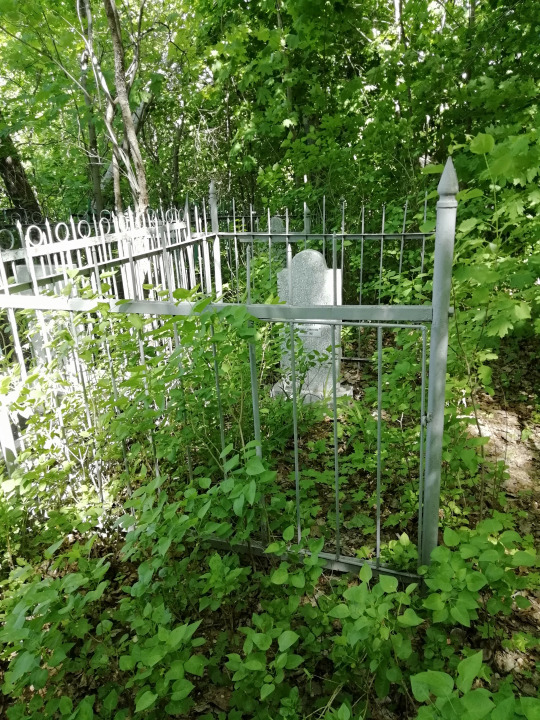
https://bit.ly/3DhUEqE — online burials catalog.
Northern cemetery is the largest cemetery in the city of Ulyanovsk. Has an area of 120 hectares. It is located near the village of Isheevka, therefore it has a second name — Isheevskoe. Located at Kinologicheskaya 3.
In 2019, after the closure of the Zavolzhsky (Arkhangelsk) cemetery, it became the main city cemetery of Ulyanovsk. More than 4 thousand graves appear on it every year. The territory of the cemetery is very close to the village of Isheevka.
There are Muslim and Jewish sites in the cemetery. The Jewish one appeared after the closure of the Old Jewish Cemetery in 1972. However, the burials of Jews in the Northern Cemetery appeared earlier. The earliest date is 1937. Belongs to Fridman Iosif Moiseevich (1911–1937).
There is a burial of 1943 and belongs to Budnevich Mikhail Iosifovich (1910–1943). If Fridman’s burial is independent, then Budnevich’s grave is family. In addition to Mikhail Iosifovich, Kochegura Raisa Mikhailovna (1948–1996) and Dolgopolskaya Anna Lvovna (1906–1969) are buried in it.
Unlike the burials at the Old Jewish Cemetery, the monuments in the Jewish section of the Northern Cemetery are standardized Soviet-era tombstones for single or family burials.
More than a dozen tombstones included in the electronic catalog contain images of the Star of David. The grave of Neiman Rimma Lvovna (1925–1995) is not only an image of the Star of David, but also a seven-branched candlestick. The slab of the family grave of Lifshits Mikhail Iosifovich (1920–2010) and Lifshitz Fani Abramovna (1924–2011) contains an image of the Star of David, as well as inscriptions in Hebrew.
There is also a grave with an Orthodox cross on the Jewish site. Seleznev Georgiy Mikhailovich (1944–2016) is buried at the site; a cross is depicted on his monument, and Belkina Gitya Grigorievna (1920–2011).
Monuments of Shakol Mikhli Evseevna (1916–2004) and Bogorad Faina Arkadyevna (1939–2005) are decorated with floral ornaments.
As a rule, inscriptions on gravestones contain a minimum of information — name, surname and dates of life. Some of the monuments indicate the professional affiliation of the deceased: surgeon Belenson Iosif Isaevich (1931–1998), professor Belyi Mikhail Izrailevich (1923–1998), honorary lawyer Shegal Arkadiy Davydovich (1929–2006).
#mitzvatemet #JewishGenealogy
0 notes
Photo
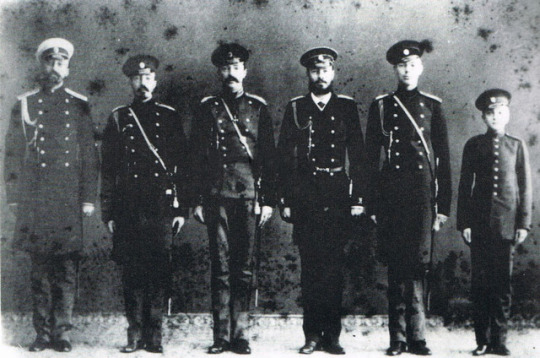
The six sons of Grand Duke Mikhail Nikolaevich: Nicholas, Mikhail, Georgiy, Alexander, Sergei and Alexei
#Russia#Romanov#Nicholas Mikhailovich#Mikhail Mikhailovich#Georgiy Mikhailovich#Alexander Mikhailovich#Sergei Mikhailovich#Alexei Mikhailovich
44 notes
·
View notes
Text
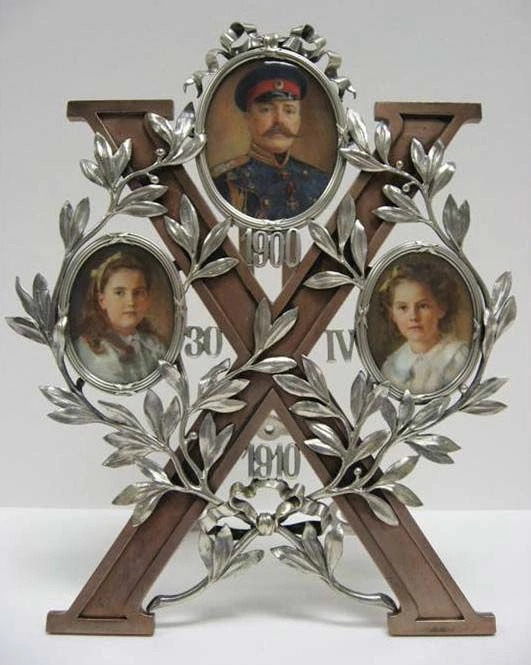
Grand Duke Georgiy Mikhailovich gave this Faberge frame to his wife, Grand Duchess Maria Georgievna (née Princess Maria of Greece and Denmark) on the occasion of their tenth wedding anniversary. It features portrait miniatures of the Grand Duke and of the couple’s two daughters, Princesses Nina and Xenia.
#grand duke georgiy mikhailovich#grand duchess maria georgievna#princess nina georgievna#princess xenia georgievna#romanov#russia#faberge
73 notes
·
View notes
Text
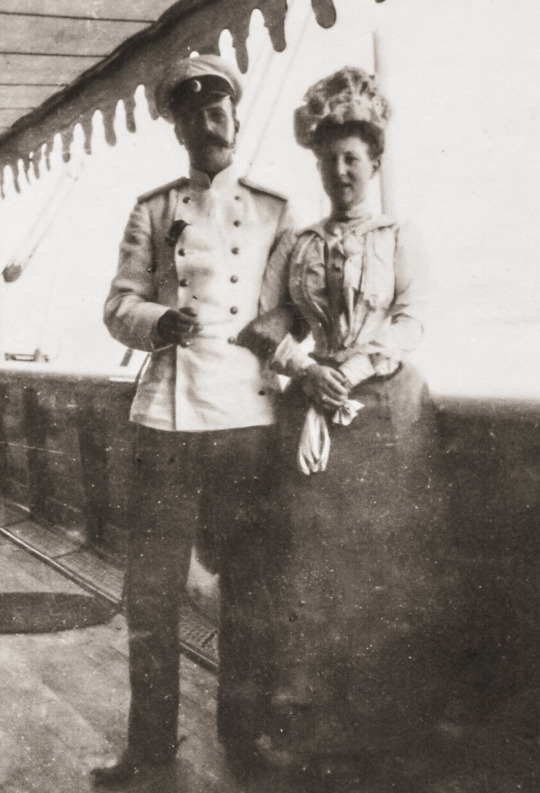
Grand Duke Georgiy Mikhailovich and his wife Grand Duchess Maria Georgievna
Reportedly, Georgiy was a lovely man with an artistic temperament (actually, he set up and directed the Alexander III Art Museum.) He was a numismatist of the first orders and material on rare coins written by him is still in use. His wife, Grand Duchess Maria Georgievna, had been in love with him when she was very young, but at the time, he was sowing his wild oats and paid no mind to her. When he asked her to marry him years later, the love on her part was gone (apparently, she had fallen in love with an unsuitable person in the Greek court.) After Alexander III told them to get it together (more or less), they married in Corfu. They had two daughters, and their marriage was not happy, although they adored their children (who liked their father better than their mother.) Right before WWI, Maria took the children to England for a "visit" (some thought it was a trial separation.) Because of the war, they could not return to Russia. Grand Duke George was imprisoned by the Bolsheviks and murdered.
#russian history#imperial russia#romanov dynasty#Grand Duke Georgiy Mikhailovich#Grand Duchess Maria Georgievna
10 notes
·
View notes
Text
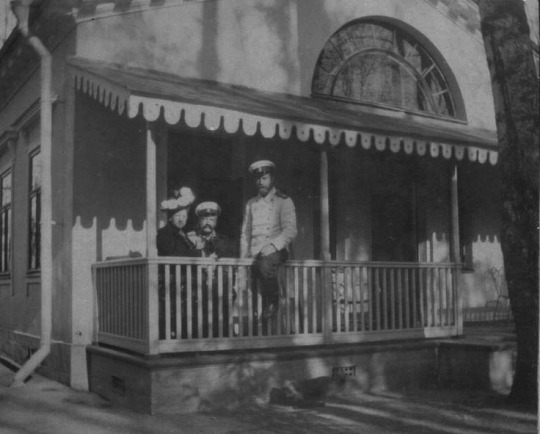
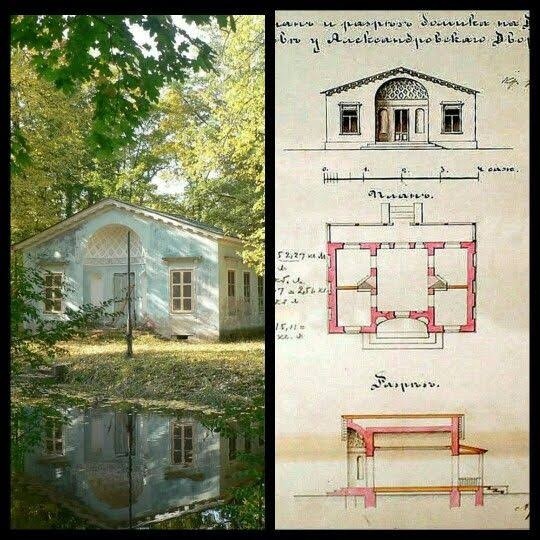
Photo at Left : Tsar Nicholas II of Russia with his paternal first cousin,once removed the Grand Duke Georgiy Mikhailovich Romanov of Russia and his wife,Grand Duchess Marie Georgievna Romanova of Russia (who is Nicky's maternal first cousin) at the back veranda of the Children's Pavilion on the Children's Island at the Alexander Park, Tsarskoe Selo.
Photo at Right : Modern view of building and the blueprint.
15 notes
·
View notes